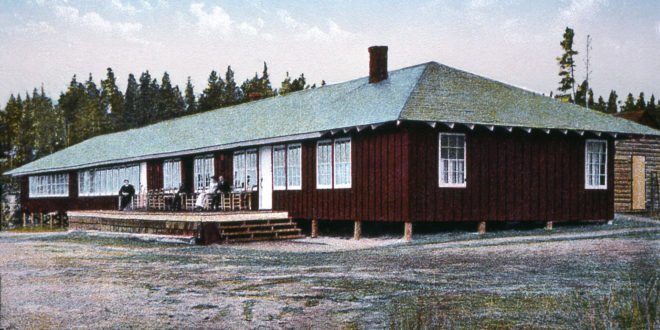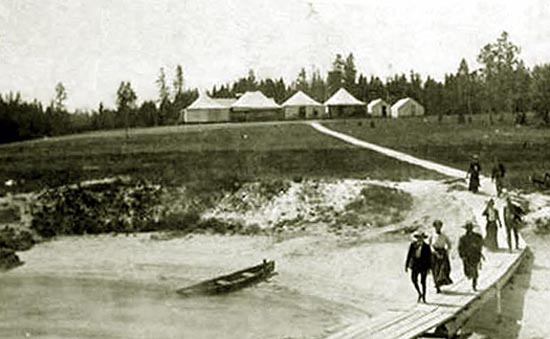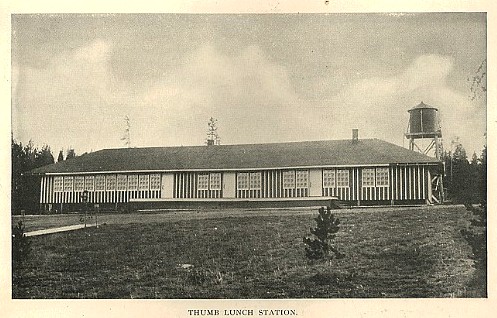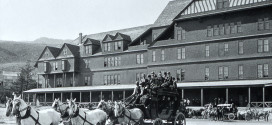A somewhat sleepy destination for some, West Thumb Geyser Basin was once a bustling part of Yellowstone, especially around the old Thumb Lunch Station.
Thumb Lunch Station arose out of a desire by park managers for lakeside accommodations. Indeed, managers had visions of West Thumb as a destination for tourists; it combined, after all, two huge selling points for Yellowstone promoters: alpine scenery and thermal wonders.
Financially strapped, however, the Yellowstone Park Association never made it past the planning state for lodging accommodations at Thumb, opting instead to open a lunch tent in 1892. You can see the Thumb lunch area, pre-Station, below.
By the early 1900s, however, it became apparent the region needed more solid accommodations, as more and more tourists came by via stagecoach. Enter architect Robert C. Reamer, of Old Faithful Inn fame, who drew up a plan for the Thumb Lunch Station in addition to his many, many other Yellowstone projects.
According to Ruth Quinn’s biography on Reamer—Weaver of Dreams—construction of the Thumb Lunch Station was swift, beginning May 25, 1903; it was operational by the swell of summer tourism.
Although designed by Reamer, the Lunch Station was nothing to write home about, a point Quinn makes in her entry for it in Weaver of Dreams:
Little appears in the historic literature describing the architectural style or construction of Thumb Lunch Station. Built on simple lines, it appeared more functional than creatively artistic. Even Y.P.A.’s own advertising failed to mention its appearance: “At the Thumb Lunch Station you will find everything neat and clean, and an appetizing lunch served, nothwithstanding the fact that you are more than a thousand miles from a market of any considerable size, and that everything provided for you has been hauled by freight teams nearly seventy-five miles over mountains rising more than 8400 feet above sea level.”
Quinn notes that infamous Yellowstone businessman E.C. Waters, who ran the Steamship Zillah business on Yellowstone Lake, used the Thumb Lunch Station as a court of sorts for courting passengers. Indeed, as historian Aubrey L. Haines notes, stagecoach drivers along the lakeshore route often helped Waters out by “boating” as many of their riders as possible so the coaches would be less weighted. It helped that Waters paid fifty cents a head to every participating coachman.
Thumb Lunch Station’s halcyon days were short, unfortunately. First, E.C. Waters was booted from the park shortly after announcing his new venture, a larger replacement for the Zillah dubbed the E.C. Waters. Second, with the advent of automobile travel in Yellowstone National Park, lunch stations like Thumb became instantly antiquated.
Indeed, according to Quinn, this fact, combined with the limits of Thumb Lunch Station’s accommodations, proved fatal:
Although Thumb Station had rooms to accommodate twenty guests, a 1911 report referred to the services available at this stop as “lunch only,” probably owing to the unwillingness of the Transportation Company to reserve empty coach seats for later pickups. But the motorcar, which did so much to democratize Yellowstone for all, sounded a death knell for Thumb Lunch Station. Along with Fountain Hotel and Norris Lunch Station, it was abandoned in 1917 as no longer needed. The improvement of the roads for automobiles, however, made the southern entrance an official park entrance, transportation companies providing service to guests on that stretch of road for the first time in 1917.
According to Quinn, Charles A. Hamilton of Hamilton store fame assumed management of the Thumb area, gaining permission from the Yellowstone Park Hotel Company to operate in the Thumb Lunch Station. Alas, he decided in 1923 to construct his own facility.
The Thumb Lunch Station was torn down in 1927. With it went one of the last vestiges of stagecoach culture in Yellowstone.
 Yellowstone Insider Your Complete Guide to America's First National Park
Yellowstone Insider Your Complete Guide to America's First National Park








You must be logged in to post a comment.